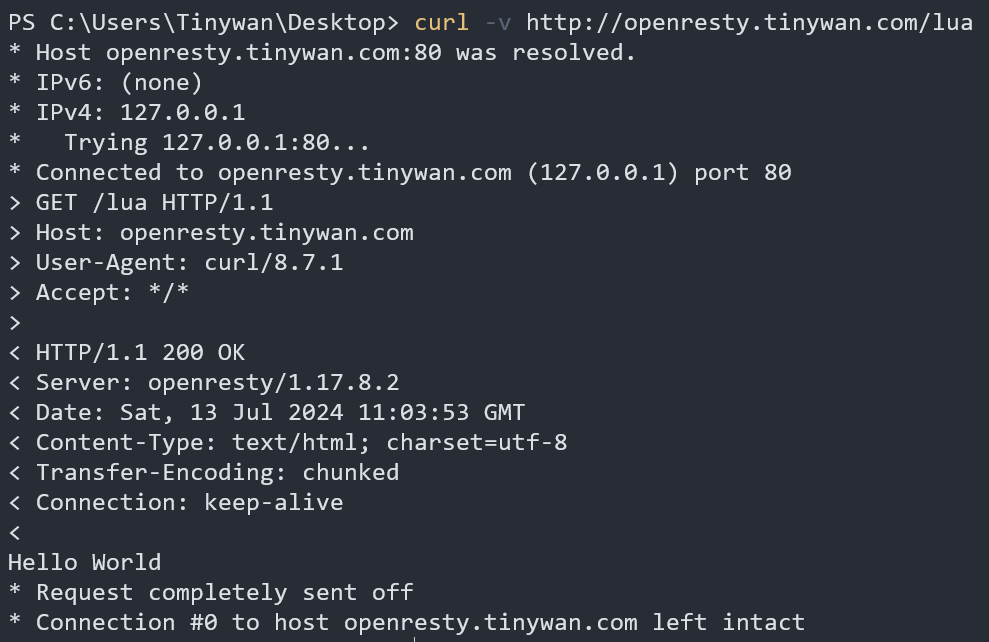如何使用Lua編寫Hello World
為了方便開發,我們在這里指定一個訪問域名:http://openresty.tinywan.com
在`/usr/local/openresty/nginx/conf`目錄下創建一個`openresty.tinywan.com.conf`
`openresty.tinywan.com.conf` 配置文件內容
```
server {
listen 80;
server_name openresty.tinywan.com;
}
```
## 編寫location
在`openresty.tinywan.com.conf` 中`server`部分添加如下配置
```
location /lua {
default_type 'text/html';
content_by_lua 'ngx.say("Hello World")';
}
```
先檢查Nginx配置文件語法是否正確
```
/usr/local/openresty/nginx/sbin/nginx -t
```
輸出以下內容表示配置
```
nginx: the configuration file /usr/local/openresty/nginx/conf/nginx.conf syntax is ok
nginx: configuration file /usr/local/openresty/nginx/conf/nginx.conf test is successful
```
重新加載配置
```
sudo systemctl restart openresty.service
```
或者
```
/usr/local/openresty/nginx/sbin/nginx -s reload
```
瀏覽器訪問`http://openresty.tinywan.com/lua`應該返回`Hello World`。

## 使用lua代碼文件
把lua代碼放在nginx配置中會隨著lua的代碼的增加導致配置文件太長不好維護,因此應該把lua代碼移到外部文件中存儲。
在`/usr/local/openresty/nginx/conf`目錄下創建一個`lua`目錄。新建一個`hello.lua`文件,添加如下內容
```
ngx.say("Hello 開源技術小棧")
```
修改`openresty.tinywan.com.conf` 配置
```
server {
listen 80;
server_name openresty.tinywan.com;
location /lua {
default_type 'text/html';
content_by_lua_file conf/lua/hello.lua; #相對于nginx安裝目錄
}
}
```
此處`conf/lua/hello.lua`也可以使用絕對路徑`/usr/local/openresty/nginx/conf/lua/hello.lua`。
重啟Openresty,重新訪問
```
curl -i http://openresty.tinywan.com/lua
```

## lua_code_cache
默認情況下`lua_code_cache` 是開啟的,默認會緩存`lua`代碼,即每次`lua`代碼變更必須`reload nginx`才生效,如果在開發階段可以通過`lua_code_cache off;`關閉緩存,這樣調試時每次修改lua代碼不需要`reload nginx`,但是正式環境一定記得開啟緩存。
```
server {
listen 80;
server_name openresty.tinywan.com;
location /lua {
default_type 'text/html';
lua_code_cache off;
content_by_lua_file conf/lua/hello.lua;
}
}
```
開啟后`reload nginx`會看到如下報警
```
nginx: [alert] lua_code_cache is off; this will hurt performance in /etc/nginx/conf.d/openresty.tinywan.com.conf:7
```
## 錯誤日志
如果運行過程中出現錯誤,請不要忘記查看錯誤日志。
```
tail -f /usr/local/openresty/nginx/logs/error.log
```
錯誤內容
```
2024/07/13 13:13:48 [emerg] 1#1: invalid return code "Hello World!" in /etc/nginx/conf.d/tinywan_lua.conf:7
2024/07/13 13:14:01 [emerg] 1#1: invalid return code "Hello World!" in /etc/nginx/conf.d/tinywan_lua.conf:7
2024/07/13 13:14:28 [emerg] 1#1: invalid return code "Hello World!" in /etc/nginx/conf.d/tinywan_lua.conf:7
```
- 設計模式系列
- 工廠方法模式
- 序言
- Windows程序注冊為服務的工具WinSW
- 基礎
- 安裝
- 開發規范
- 目錄結構
- 配置
- 快速入門
- 架構
- 請求流程
- 架構總覽
- URL訪問
- 容器和依賴注入
- 中間件
- 事件
- 代碼層結構
- 四個層次
- 路由
- 控制器
- 請求
- 響應
- 數據庫
- MySQL實時同步數據到ES解決方案
- 阿里云DTS數據MySQL同步至Elasticsearch實戰
- PHP中的MySQL連接池
- PHP異步非阻塞MySQL客戶端連接池
- 模型
- 視圖
- 注解
- @SpringBootApplication(exclude={DataSourceAutoConfiguration.calss})
- @EnableFeignClients(basePackages = "com.wotu.feign")
- @EnableAspectJAutoProxy
- @EnableDiscoveryClient
- 錯誤和日志
- 異常處理
- 日志處理
- 調試
- 驗證
- 驗證器
- 驗證規則
- 擴展庫
- 附錄
- Spring框架知識體系詳解
- Maven
- Maven和Composer
- 構建Maven項目
- 實操課程
- 01.初識SpringBoot
- 第1章 Java Web發展史與學習Java的方法
- 第2章 環境與常見問題踩坑
- 第3章 springboot的路由與控制器
- 02.Java編程思想深度理論知識
- 第1章 Java編程思想總體
- 第2章 英雄聯盟的小案例理解Java中最為抽象的概念
- 第3章 徹底理解IOC、DI與DIP
- 03.Spring與SpringBoot理論篇
- 第1章 Spring與SpringBoot導學
- 第2章 Spring IOC的核心機制:實例化與注入
- 第3章 SpringBoot基本配置原理
- 04.SprinBoot的條件注解與配置
- 第1章 conditonal 條件注解
- 第2章 SpringBoot自動裝配解析
- 05.Java異常深度剖析
- 第1章 Java異常分類剖析與自定義異常
- 第2章 自動配置Url前綴
- 06.參數校驗機制與LomBok工具集的使用
- 第1章 LomBok工具集的使用
- 第2章 參數校驗機制以及自定義校驗
- 07.項目分層設計與JPA技術
- 第1章 項目分層原則與層與層的松耦合原則
- 第2章 數據庫設計、實體關系與查詢方案探討
- 第3章 JPA的關聯關系與規則查詢
- 08.ORM的概念與思維
- 第1章 ORM的概念與思維
- 第2章 Banner等相關業務
- 第3章 再談數據庫設計技巧與VO層對象的技巧
- 09.JPA的多種查詢規則
- 第1章 DozerBeanMapper的使用
- 第2章 詳解SKU的規格設計
- 第3章 通用泛型Converter
- 10.令牌與權限
- 第1章 通用泛型類與java泛型的思考
- 常見問題
- 微服務
- demo
- PHP中Self、Static和parent的區別
- Swoole-Cli
- 為什么要使用現代化PHP框架?
- 公眾號
- 一鍵部署微信公眾號Markdown編輯器(支持適配和主題設計)
- Autodesigner 2.0發布
- Luya 一個現代化PHP開發框架
- PHPZip - 創建、讀取和管理 ZIP 文件的簡單庫
- 吊打Golang的PHP界天花板webman壓測對比
- 簡潔而強大的 YAML 解析庫
- 推薦一個革命性的PHP測試框架:Kahlan
- ServBay下一代Web開發環境
- 基于Websocket和Canvas實現多人協作實時共享白板
- Apipost預執行腳本如何調用外部PHP語言
- 認證和授權的安全令牌 Bearer Token
- Laradock PHP 的 Docker 完整本地開發環境
- 高效接口防抖策略,確保數據安全,避免重復提交的終極解決方案!
- TIOBE 6月榜單:PHP穩步前行,編程語言生態的微妙變化
- Aho-Corasick字符串匹配算法的實現
- Redis鍵空間通知 Keyspace Notification 事件訂閱
- ServBay如何啟用并運行Webman項目
- 使用mpdf實現導出pdf文件功能
- Medoo 輕量級PHP數據庫框架
- 在PHP中編寫和運行單元測試
- 9 PHP運行時基準性能測試
- QR碼生成器在PHP中的源代碼
- 使用Gogs極易搭建的自助Git服務
- Gitea
- webman如何記錄SQL到日志?
- Sentry PHP: 實時監測并處理PHP應用程序中的錯誤
- Swoole v6 Alpha 版本已發布
- Proxypin
- Rust實現的Redis內存數據庫發布
- PHP 8.4.0 Alpha 1 測試版本發布
- 121
- Golang + Vue 開發的開源輕量 Linux 服務器運維管理面板
- 內網穿透 FRP VS Tailscale
- 新一代開源代碼托管平臺Gitea
- 微服務系列
- Nacos云原生配置中心介紹與使用
- 輕量級的開源高性能事件庫libevent
- 國密算法
- 國密算法(商用密碼)
- GmSSL 支持國密SM2/SM3/SM4/SM9/SSL 密碼工具箱
- GmSSL PHP 使用
- 數據庫
- SQLite數據庫的Web管理工具
- 阿里巴巴MySQL數據庫強制規范
- PHP
- PHP安全測試秘密武器 PHPGGC
- 使用declare(strict_types=1)來獲得更健壯的PHP代碼
- PHP中的魔術常量
- OSS 直傳阿里騰訊示例
- PHP源碼編譯安裝APCu擴展實現數據緩存
- BI性能DuckDB數據管理系統
- 為什么別人可以是架構師!而我卻不是?
- 密碼還在用 MD5 加鹽?不如試試 password_hash
- Elasticsearch 在電商領域的應用與實踐
- Cron 定時任務入門
- 如何動態設置定時任務!而不是寫死在Linux Crontab
- Elasticsearch的四種查詢方式,你知道多少?
- Meilisearch vs Elasticsearch
- OpenSearch vs Elasticsearch
- Emlog 輕量級開源博客及建站系統
- 現代化PHP原生協程引擎 PRipple
- 使用Zephir編寫C擴展將PHP源代碼編譯加密
- 如何將PHP源代碼編譯加密,同時保證代碼能正常的運行
- 為什么選擇Zephir給PHP編寫動態擴展庫?
- 使用 PHP + XlsWriter實現百萬級數據導入導出
- Rust編寫PHP擴展
- 阿里云盤開放平臺對接進行文件同步
- 如何構建自己的PHP靜態可執行文件
- IM后端架構
- RESTful設計方法和規范
- PHP編譯器BPC 7.3 發布,成功編譯ThinkPHP8
- 高性能的配置管理擴展 Yaconf
- PHP實現雪花算法庫 Snowflake
- PHP官方現代化核心加密庫Sodium
- pie
- 現代化、精簡、非阻塞PHP標準庫PSL
- PHP泛型和集合
- 手把手教你正確使用 Composer包管理
- JWT雙令牌認證實現無感Token自動續期
- 最先進PHP大模型深度學習庫TransformersPHP
- PHP如何啟用 FFI 擴展
- PHP超集語言PXP
- 低延遲雙向實時事件通信 Socket.IO
- PHP OOP中的繼承和多態
- 強大的現代PHP高級調試工具Kint
- PHP基金會
- 基于webman+vue3高質量中后臺框架SaiAdmin
- 開源免費的定時任務管理系統:Gocron
- 簡單強大OCR工具EasyOCR在PHP中使用
- PHP代碼抽象語法樹工具PHP AST Viewer
- MySQL數據庫管理工具PHPMyAdmin
- Rust編寫的一款高性能多人代碼編輯器Zed
- 超高性能PHP框架Workerman v5.0.0-beta.8 發布
- 高并發系列
- 入門介紹及安裝
- Lua腳本開發 Hello World
- 執行流程與階段詳解
- Nginx Lua API 接口開發
- Lua模塊開發
- OpenResty 高性能的正式原因
- 記一次查找 lua-resty-mysql 庫 insert_id 的 bug
- 包管理工具OPM和LuaRocks使用
- 異步非阻塞HTTP客戶端庫 lua-resty-http
- Nginx 內置綁定變量
- Redis協程網絡庫 lua-resty-redis
- 動態HTML渲染庫 lua-testy-template
- 單獨的
- StackBlitz在線開發環境
- AI
- 基礎概念
- 12312
- 基礎鏡像的坑
- 利用phpy實現 PHP 編寫 Vision Transformer (ViT) 模型
- 語義化版本 2.0.0
